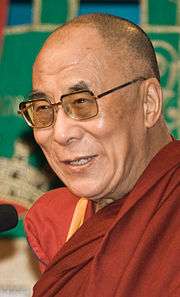Kundun
Kundun is a 1997 American epic biographical film written by Melissa Mathison and directed by Martin Scorsese. It is based on the life and writings of Tenzin Gyatso, the 14th Dalai Lama, the exiled political and spiritual leader of Tibet. Tenzin Thuthob Tsarong, a grandnephew of the Dalai Lama, stars as the adult Dalai Lama, while Tencho Gyalpo, a niece of the Dalai Lama, appears as the Dalai Lama's mother.
| Kundun | |
|---|---|
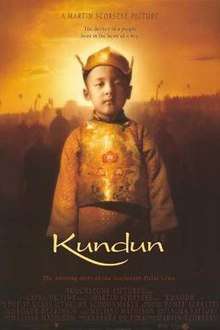 Theatrical release poster | |
| Directed by | Martin Scorsese |
| Produced by | Barbara De Fina |
| Written by | Melissa Mathison |
| Starring |
|
| Music by | Philip Glass |
| Cinematography | Roger Deakins |
| Edited by | Thelma Schoonmaker |
Production company | |
| Distributed by | Buena Vista Pictures |
Release date |
|
Running time | 134 minutes |
| Country | United States |
| Language | English |
| Budget | $28 million[1] |
| Box office | $5.7 million[1] |
The film according to Roger Ebert was "made of episodes, not a plot" and he gave the film three stars out of four. Stephen Holden of The New York Times called the film "emotionally remote" but praised its look and its musical score. Richard Corliss praised the cinematography and score as well. Barry Norman, chief film critic at the BBC opined that Kundun was both beautifully and intelligently made.
"Kundun" (སྐུ་མདུན་ Wylie: sku mdun in Tibetan), meaning "presence", is a title by which the Dalai Lama is addressed. Kundun was released only a few months after Seven Years in Tibet, sharing the latter's location and its depiction of the Dalai Lama at several stages of his youth, though Kundun covers a period three times longer.
Plot
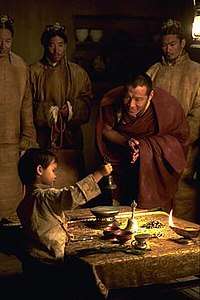
The film has a linear chronology with events spanning from 1937 to 1959;[2] the setting is Tibet, except for brief sequences in China and India. It begins with the search for the 14th mindstream emanation of the Dalai Lama. After a vision by Reting Rinpoche (the regent of Tibet) several lamas disguised as servants discover a promising candidate: a child born to a farming family in the province of Amdo, near the Chinese border.
These and other lamas administer a test to the child in which he must select from various objects the ones that belonged to the previous Dalai Lama. The child passes the test, and he and his family are brought to Potala Palace in Lhasa, where he will be installed as Dalai Lama when he comes of age.
During the journey, the child becomes homesick and frightened, but is comforted by Reting, who tells him the story of the first Dalai Lama–whom the lamas called "Kundun". As the film progresses, the boy matures in both age and learning. After a brief power struggle in which Reting is imprisoned and dies, the Dalai Lama begins taking a more active role in governance and religious leadership.
Meanwhile, the Chinese communists, recently victorious in their revolution, are proclaiming Tibet a traditional part of Imperial China and express their desire to reincorporate it with the newly formed People's Republic of China. Eventually, despite Tibet's pleas to the United Nations, the United States, the United Kingdom, and India for intervention, Chinese Communist forces invade Tibet. The Chinese are initially helpful, but when the Tibetans resist Communist reorganization and reeducation of their society, the Chinese become oppressive.
Following a series of atrocities suffered by his people, the Dalai Lama resolves to meet with Chairman Mao Zedong in Beijing. While Mao publicly expresses his sympathies to the Tibetan people and the Dalai Lama, and insists that changes must be made as the Dalai Lama sees fit, relations inevitably deteriorate. During their face-to-face meeting on the final day of the Dalai Lama's visit, Mao makes clear his socialist view that "religion is poison" and that the Tibetans are "poisoned and inferior" because of it.
Upon his return to Tibet, the Dalai Lama learns of more horrors perpetrated against his people, who have by now repudiated their treaty with China and begun guerrilla action against the Chinese. After the Chinese make clear their intention to kill him, the Dalai Lama is convinced by his family and his Lord Chamberlain to flee to India.
After consulting the Nechung Oracle about the proper escape route, the Dalai Lama and his staff put on disguises and slip out of Lhasa under cover of darkness. During an arduous journey, throughout which they are pursued by the Chinese, the Dalai Lama becomes very ill and experiences two personal visions, first that their trip to India will be propitious and that, similarly, their eventual return to Tibet will also be propitious. The group eventually makes it to a small mountain pass on the Indian border. As the Dalai Lama walks to the guard post, an Indian guard approaches him, salutes, and inquires: "Are you the Lord Buddha?" The Dalai Lama replies with the film's final line: "I think that I am a reflection, like the moon on water. When you see me, and I try to be a good man, you see yourself." Once the Dalai Lama arrives at his new residence, he unpacks his telescope and steps outside. Erecting it and removing his spectacles, he gazes through it toward the Himalayas–and toward Tibet. The film concludes with two lines printed on screen: "The Dalai Lama has not yet returned to Tibet. He hopes one day to make the journey." The words shimmer into a dissolve upon the black screen as the credits begin.
Cast
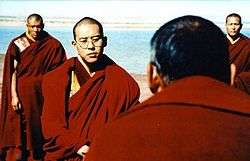
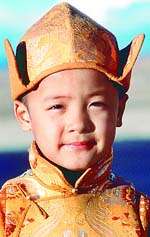
- Tenzin Thuthob Tsarong as the Dalai Lama (Adult)
- Gyurme Tethong as the Dalai Lama (Age 12)
- Tulku Jamyang Kunga Tenzin as the Dalai Lama (Age 5)
- Tenzin Yeshi Paichang as the Dalai Lama (Age 2)
- Tencho Gyalpo as the Dalai Lama's mother
- Tenzin Topjar as Lobsang (age 5 to 10)
- Tsewang Migyur Khangsar as the Dalai Lama's father
- Tenzin Lodoe as Takster Rinpoche
- Tsering Lhamo as Tsering Dolma
- Geshi Yeshi Gyatso as the Lama of Sera
- Losang Gyatso as The Messenger (as Lobsang Gyatso)
- Sonam Phuntsok as Reting Rinpoche
- Gyatso Lukhang as Lord Chamberlain
- Lobsang Samten as Master of the Kitchen
- Jigme Tsarong as Taktra Rinpoche (as Tsewang Jigme Tsarong)
- Tenzin Trinley as Ling Rinpoche
- Robert Lin as chairman Mao Zedong
- Jurme Wangda as Prime Minister Lukhangwa
- Jill Hsia as Little Girl
Production
The project began when screenwriter Melissa Mathison, whose best-known work was ET, met with the Dalai Lama and asked him if she could write about his life. According to Turner Classic Movies, "he gave her his blessing and his time, sitting for interviews that became the basis of her script"; it was Mathison's suggestion that Scorsese be brought in as director.[3]
Most of the film was shot at the Atlas Film Studios in Ouarzazate, Morocco; some scenes were filmed at the Karma Triyana Dharmachakra monastery in Woodstock, New York.[4][5]
Soundtrack
All tracks were composed by Philip Glass. Music was conducted by Michael Riesman. Music was produced by Kurt Munkacsi. The Executive Music Producer was Jim Keller.
Track listing
- "Sand Mandala" – 4:04
- "Northern Tibet" - 3:21
- "Dark Kitchen" - 1:32
- "Choosing" - 2:13
- "Reting's Eyes" - 2:18
- "Potala" - 1:29
- "Lord Chamberlain" - 2:43
- "Norbu Plays" - 2:12
- "Norbulingka" - 2:17
- "Chinese Invade" - 7:05
- "Fish" - 2:10
- "Distraught" - 2:59
- "Thirteenth Dalai Lama" - 3:23
- "Move to Dungkar" - 5:04
- "Projector" - 2:04
- "Lhasa at Night" - 1:58
- "Escape to India" - 10:05
Release
Even before the film was released, China's leaders hotly objected to Disney's plans to distribute the film, even to the point of threatening Disney's future access to China as a market.[6] Disney's steadfastness stood in stark contrast to Universal Pictures, which had earlier "turned down the chance to distribute Kundun for fear of upsetting the Chinese."[6] Scorsese, Mathison, and several other members of the production were banned by the Chinese government from ever entering China as a result of making the film.[7][8] China retaliated by banning Disney films and pulling Disney television cartoons.[9] Disney apologized in 1998 for releasing the film and began to "undo the damage", eventually leading to a deal to open Shanghai Disneyland by 2016.[10]
Reception
The film failed at the box office, taking in less than $6 million in a limited U.S. distribution.[1] Kundun was nominated for four Academy Awards: for Best Art Direction (Dante Ferretti, art direction and Francesca Lo Schiavo, set decoration), Best Cinematography (Roger Deakins), Best Costume Design, and Best Original Score (Philip Glass). The film holds a 75% "Fresh" rating on Rotten Tomatoes based on 61 reviews, indicating generally positive reviews. The critical consensus states: "Hallucinatory but lacking in characterization, Kundun is a young Dalai Lama portrait presented as a feast of sight and sound."[11]
Critical reviews
The film according to Roger Ebert was "made of episodes, not a plot".[12] Stephen Holden of The New York Times called the film "emotionally remote" while praising its look and its score: "The movie is a triumph for the cinematographer Roger Deakins, who has given it the look of an illuminated manuscript. As its imagery becomes more surreal and mystically abstract, Mr. Glass's ethereal electronic score, which suggests a Himalayan music of the spheres, gathers force and energy and the music and pictures achieve a sublime synergy."[2] Richard Corliss praised the cinematography and score as well: "Aided by Roger Deakins' pristine camera work and the euphoric drone of Philip Glass's score, Scorsese devises a poem of textures and silences. Visions, nightmares and history blend in a tapestry as subtle as the Tibetans' gorgeous mandalas of sand."[6]
Roger Ebert gave the film three stars out of four, saying: "There is rarely the sense that a living, breathing and (dare I say?) fallible human inhabits the body of the Dalai Lama. Unlike Scorsese's portrait of Jesus in The Last Temptation of Christ, this is not a man striving for perfection, but perfection in the shape of a man. ... Once we understand that Kundun will not be a drama involving a plausible human character, we are freed to see the film as it is: an act of devotion, an act even of spiritual desperation, flung into the eyes of 20th century materialism. The film's visuals and music are rich and inspiring, and like a mass by Bach or a Renaissance church painting, it exists as an aid to worship: It wants to enhance, not question."[12] David Edelstein called the movie a hagiography whose "music ties together all the pretty pictures, gives the narrative some momentum, and helps to induce a kind of alert detachment, so that you're neither especially interested nor especially bored."[13]
Michael Wilmington of The Chicago Tribune gave the film four stars out of four, writing: "Hauntingly beautiful, raptly serious and vastly ambitious, Kundun is exactly the sort of movie that critics complain the major Hollywood studios never make -- and then tend to ignore or underrate when it finally appears." [14]
Barry Norman, chief film critic at the BBC opined that Kundun was "beautifully and intelligently made, far more impressive, for instance, than the recent Seven Years in Tibet".[15] As Kundun was released in the UK four months after its original release, Norman was able to probe Scorsese about the film's promotion. Writing about his interview with Scorsese, Norman said,
Yet it seems to be Scorsese, rather than the studio, who is doing most to promote the film. So I asked him "Did Disney back you up when it came out? Did they really put themselves behind it to try to sell it?" Now Scorsese is a decent and diplomatic man, who likes to be fair to everybody, but eventually he said: "I personally think that, unfortunately, they didn't push the picture." For fear of offending China? "Who knows?" he said. But, perhaps significantly, he also said: "The market China represents is enormous, not just for Disney but many other corporations around the world."[15]
In popular culture
In second episode of The Sopranos, titled "46 Long", Christopher Moltisanti and Brendan Filone see Martin Scorsese outside a club, to whom Christopher says, "Marty! Kundun, I liked it."
The movie inspired the writing of the song "Chinese Democracy" off the album of the same name by hard rock band Guns N' Roses.[16]
In 2017 the web series Lasagna Cat featured the film's complete score in the hour-long episode "07/27/1978", in which John Blyth Barrymore delivers a philosophical monologue about a Garfield strip published on the titular date.[17]
Accolades
References
- Kundun from The Numbers
- December 24, 1997 Review from The New York Times
- Overview of Kundun from the Turner Classic Movies website
- "Karma Triyana Dharmachakra – The Monastery". Archived from the original on December 5, 2016. Retrieved May 29, 2008.
- "Young Spiritual Leader Arrives in New York Ready to Teach and Be Taught" from the New York Times May 16, 2008
- Disney's China Policy from Time magazine
- "Change of direction for Scorsese". The National.
- "37 Celebrities Banned From Foreign Countries". BuzzFeed. Archived from the original on November 16, 2012. Retrieved September 2, 2017.
- Barboza, David; Barnes, Brooks (June 14, 2016). "How China Won the Keys to Disney's Magic Kingdom". The New York Times. Retrieved December 17, 2017.
- Brzeski, Patrick (June 8, 2016). "Shanghai Disney Resort Finally Opens After 5 Years of Construction and $5.5B Spent". The Hollywood Reporter. Archived from the original on June 9, 2016. Retrieved June 9, 2016.
- "Kundun Reviews". Rotten Tomatoes. Flixster. Retrieved February 16, 2010.
- Review by Roger Ebert
- Edelstein, David (December 26, 1997). "Holding Their Fire". Slate. Retrieved September 23, 2008.
- Wilmington, Michael (January 16, 1998). "HEAVEN SENT". Chicago Tribune. Retrieved January 29, 2010.
- "Martin Scorsese's KUNDUN conundrum". Radio Times. April 4–10, 1998.
- Flumenbaum, David (February 24, 2009). "China Bans Democracy, Declares War on Guns N' Roses". The Huffington Post. Archived from the original on July 11, 2015. Retrieved July 29, 2015.
- "Garfield, by smoking a pipe, has opened up a whole new world of dumb internet Garfield jokes". News. Archived from the original on December 1, 2019. Retrieved August 8, 2020.
External links
| Wikiquote has quotations related to: Kundun |
- Kundun on IMDb
- Kundun at Rotten Tomatoes
- Kundun at Box Office Mojo
